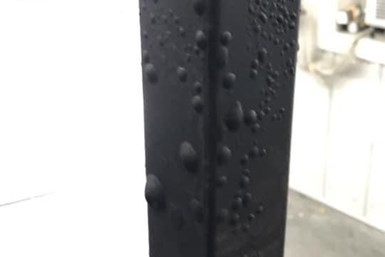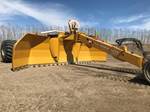How to Prevent Outgassing of Iron Castings
Verney Denerville of TIGER Drylac outlines the procedure used to mitigate the outgassing of iron castings.
Share

If gasses are not expelled from metal prior to powder coating, problems such as bumps, bubbles and pinholes can occur.
Photo Credit: TIGER Drylac
Q: How do I prevent defects caused by outgassing of iron castings?
Cast metal surfaces such as iron, steel and aluminum are not always forgiving in the powder coating world. These metals trap pockets of gasses, air and other contaminants within the metal during the casting process. Shops must expel these gasses and impurities from the metal before powder coating.
The process of releasing entrapped gasses or contaminates is called outgassing. If a shop does not properly outgas, problems such as bumps, bubbles and pinholes will lead to intercoat adhesion loss and rework. Outgassing takes place when heating the substrate, which causes the metal to expand and expel the trapped gasses and other impurities. It is essential to note that entrapped gasses or contaminants within the substrate are released during the powder coating curing process as well. In addition, gasses can release during the process that was used to cast the substrate (sand pouring or die type).
The industry uses the following steps to mitigate outgassing from iron casting:
- Operators should set the oven temperature slightly higher than normal curing parameters, but no greater than 450°F. Parts in an oven set at 400° – 420°F should have a dwell time of 45 – 50 minutes depending on the substrate gauge (burn off) and how long it takes the substrate to get to temperature.
- After removing the parts from the oven, operators must allow them to cool before beginning the surface preparation (blasting process) using sand or steel shot. It is critical to make sure the metal is cool during this step to prevent blast media from sticking in the pores of the expanded metals.
- For extra reassurances, parts can be placed back in the oven for additional burn off after surface preparation.
- Once there is a proper profile for powder adherence, operators can use high-pressure air to remove any media residue.
- Finally, operators can use special primers and top coats formulated to assist with outgassing during the cure process (such as TIGER DRYLAC’s OGF Primer and OGF Top-Coats).
In addition, there are products, such as an OGF additive that can be dry blended in with powder coatings on site to assist with this phenomenon. When it comes to powder coating cast metals, these steps can be tricky and will take some additional time. However, this little bit of extra time amounts to a fraction of the time it would take for rework and starting the entire process over again. While not a foolproof solution, using this process along with specially formulated primers and topcoats can help mitigate outgassing problems.
Related Content
-
Curing Oven Basics
Simply heating up the substrate does not cure the coating. There are many variables to consider when choosing the best cure oven for your application...
-
How to Maximize Nickel Plating Performance
The advantages of boric acid-free nickel plating include allowing manufacturers who utilize nickel plating to keep up the ever-changing regulatory policies and support sustainability efforts.
-
Conveyors and Paint Systems
Choosing the right conveyor system, coating technology, and ancillary equipment.








.jpg;maxWidth=300;quality=90)




